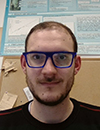David Ricart Fort, PhD Student, Escola Politècnica Superior d'Enginyeria de Manresa (EPSEM)
I graduated in nanoscience and nanotechnology at the Universitat Autònoma de Barcelona (UAB). Then I did a master in natural resources and environmental engineering at the Escola Politècnica Superior d'Enginyeria de Manresa (EPSEM). My doctoral thesis starts at the end of 2021 at EPSEM. The objective is to monitor using a 3D printed modular FIA system with an optical detector the concentration of key analytes in a bioreactor for a bioleaching process to recover copper in mobile phones. At the moment, even if it is already published, the system for Fe(III) is already done and now I will present the one for Cu(II). My research interests go with the objective of recycling everything, that is, that nothing can be considered as waste but as a resource. |





